When you take a step back, and look peer into our world’s past, you’d probably think that our people are pretty messed up. I mean c’mon , we don’t really have the cleanest record. Im sure for you it seems as though nothing could ever be done to make up for the horrors done. For many just the thought of our past wrongs makes them shy away from the page. History does not lead us to believe we are good, yet, we still manage to advance and grow through life. As humans that is pretty much our defining feature. Beside for the whole smartest beings on the planet thing, humans always have a way of adapting. This includes the fact that we live in almost every corner of this world, but also our problem solving qualities. We are constantly finding solutions, constantly looking for that better way to do things, and failures and countless mistakes, we are able to grow our understandings to overcome and resolve the these conflicts in our way. Besides for some of the problems we have caused such as climate change, not only our resilience but our constant adaption has allowed us to resolve issues in our society and conflicts between people. As long as our faults such as fear or greed don’t fog our minds, we as a people are able to find our way to resolution through the largest of mazes.

In this past project we have discovered how humans are able to move on from history’s darkest of times and what it takes to heal wounds that had been cut deep in our past. In The Ology of Apology project, we discovered the importance of apology and remembrance when solving resolving past wrongs. We also discovered how we as a people have been able to move on and grow without forgetting our past.
As I mentioned in my previous post, history will repeat itself when we don’t learn from our past actions. The question we were asked to answer by the end of this project highlighted that point as well as ways we as a people can make past wrongs, right. “How can we create a public memory of past wrongs so they are not repeated today?” Was the Driving Question of our learning this project.
Source: Brian Hughs
— Arthur Danto, art critic and philosopher
Why do we build monuments and memorials? Put simply, they are a way of creating and maintaining a public memory.
Monuments and memorials are often built to celebrate great moments in history, accomplishments, and in commemoration of great leaders. They can also be used to focus attention on moments from the past that deserve attention (not celebration).
Every society has actions and events from the past that today they view differently—however, not every society chooses to memorialize these transgressions. Not every society want to keep uncomfortable memories alive. Bryan Stevenson, Director of the Equal Justice Initiative in Montgomery, Alabama, has argued that ongoing history of racial injustice in the United States could best be addressed by the building of more memorials. He suggests that memorials "tell the full story… creating space—both physically and in our national dialog—to confront our nation's history of racial inequality and economic injustice".
Defining Memorialization
Memorialization can take a wide variety of forms—from formal museums and monuments that evolve over years and cost millions of dollars to ephemeral collections of condolence notes, flowers, and pictures of victims at sites where they died or vanished.
No matter the scale or cost, they serve the same purposes:
- Truth-telling or documenting specific human rights violations
- Creating a specific place for the immediate family and/or the larger society to mourn victims
- Offering symbolic reparations to honour the victims of violence and reinstate their reputations
- Symbolizing a community’s or nation’s commitment to values such as democracy and human rights
- Promoting reconciliation by recasting the national identity or repairing damaged relations among groups
- Encouraging civic engagement and education programs to engage the wider community in a dialogue about the past and promote discussions of a peaceful future based on coexistence
- Advancing educational purposes, including the retelling of history for future generations
- Facilitating historic preservation of a specific era in a country’s or community’s history
As I reflect on this past project, I realize not only how much I Learned, but how much I am able to remember. I know your probably thinking that learning and remembering are the same thing, but there really not. I can say that I have learned a lot since grade 1 of elemtary school, but if you asked me how much I remember, not nearly as much would reach my lips. The knowledge is still implanted in my brain, but its not memorable enough to rise to my thoughts. This project was different. With the help of Craft and its linking and note taking capabilities, as well as some help from our pervious Zettlekasten inquiries, I was able to construct and connect my knowledge as well as opinions I had on each topic.
To me, this idea of a second brain originally seemed to be un-attainable, but after putting as much effort to water my web of thoughts as I did, I am able to leave this project with ideas that I have formed that will carry throughout my leaning endeavours. I can credit my effort during our winter exhibition to these connections and ideas I made.
As I said earlier, this project covered the idea of making past wrongs, right, but the question we were asked mentioned the idea of a public memory. Where do those two meet? Well… they actually usually go hand in hand. If you think about our history and the major events in it, what do almost all of them have in common?…well, Some sort of memorial or monument. It’s true that not all memorials aren’t for something bad, but when you think of any major event in the past and what it caused, the only true way you can repay the effected individuals is by stating their importance in our history. Monuments and memorials play a pivotal role in creating that public memory so these moments in history wont be forgot as the future unrolls.
This project kept that idea in mind and focused our interest to the city we live in: Vancouver. For being a young city, our history runs deeper than the marina trench and the patterns that we can find in our past, actually relates to most of our world around us. Learning about Vancouver’s history has actually been a top interest of mine ever since our Canadian history project last year, and having the opportunity to venture into the streets and actually learn about the events where they happened, was extremely exiting and empowering.

The three case studies we covered were: Japanese Internment during WWII, Chinese exclusion, and The Komagata Maru incident of 1914. For each of these topics we went on a field study to the location each was connected to.

After gaining basic knowledge in the classroom, we set off on each of the trips where we would discover new, eye opening ideas as well as receive thorough answers to any questions we had which was unlike anything we could have gotten from a text book. I can reflect on those trips and acknowledge the importance each one played in changing my worldview to understand my role in these kind of events. We learned about what it took to make up for the 3 unjustifiable events, and how each apology made, effected the city we know today.

Reflecting on the trips, I understand that the connection between them all was how fear not only of the “other” but the “other” taking your livelihood, influenced all of the case studies. After gaining the knowledge of these events, I found it very interesting how events so large in some lives can be so little in others, even though they live in the same area. This comments on the idea of informing the public or making that public memory.
Like many living in Vancouver, I immigrated from somewhere else and arrived in this city for a purpose. Whether that purpose be as somthing as little as my parent moving for work, or somthing as large as a better life with livable pay, all immigrants share a desire for opportunity. Although, when you think about immigration in the 19th century, you dont think about the fact that those immigrants were some of the first in western Canada. South Asian, Chinese, and white settlers all were arriving near the same time, yet, the non white Canadians, weren’t event thought as Canadian. Now, immigration is almost welcomed in Canada from almost anywhere in the world. So what changed? As a PLP 10 class, we learned the answer to that question, and more questions I had formed since I moved here all those years ago.

Being together as class as we immersed ourselves in the knowledge our leaders had to offer was very special. It had been about 3 years since our last field study and the experiences as well as the shared interest of my peers made learning so much more interesting and memorable. We had all visited the locations many times before but it was incredible to learn the significance and meaning these places held, some knowledge I may never have discovered otherwise. The immersive learning allowed me to find answers to the many questions I had posed about Vancouver’s history, as well as share my knowledge with my family who also may have never known of this un-seen past. These trips made me realize that one event’s impact never truly ends until it it is forgotten. As I stood in the streets of China Town, or soaked my shoes in the puddles of Hastings Park, I realized that me being there was also a result of the event or time period. I share my experience to my family, or to the readers of this post, who may visit the cites someday, and they would share their experiences with more people. I think that’s what’s so special about being “there” instead of just reading about “there” in a book: It’s the personal connection to the event and the relization of your role in history as well as the future.

These trips were also where my Zettlekasten was loaded with ideas. Visiting the cites where the events took place allowed my constant thinking to form into meaningful perspectives and connections. I didn’t always have the clearest of ideas, but I always wrote them down, hoping to look back and remember the experience and what it meant to me and my learning.
Although the trips were all eye opening experiences, it was the bus rides after that really changed the outcome of my learning. I knew that it was only a matter of time before the newfound-knowledge of the tour or museum panels would soon fade, so I decided to record every fact or thought I obtained as soon as I got into the bus. Later, with my bullet points of knowledge, I would piece them together into a literature note and with that literature note, I would form my own thoughts and views on the subjects in the form of a permanent note. I found that doing that extra work, freed me for the future to focus on constructing those deep thoughts, not just on the field studies, but on the philosophies towards my own worldview.
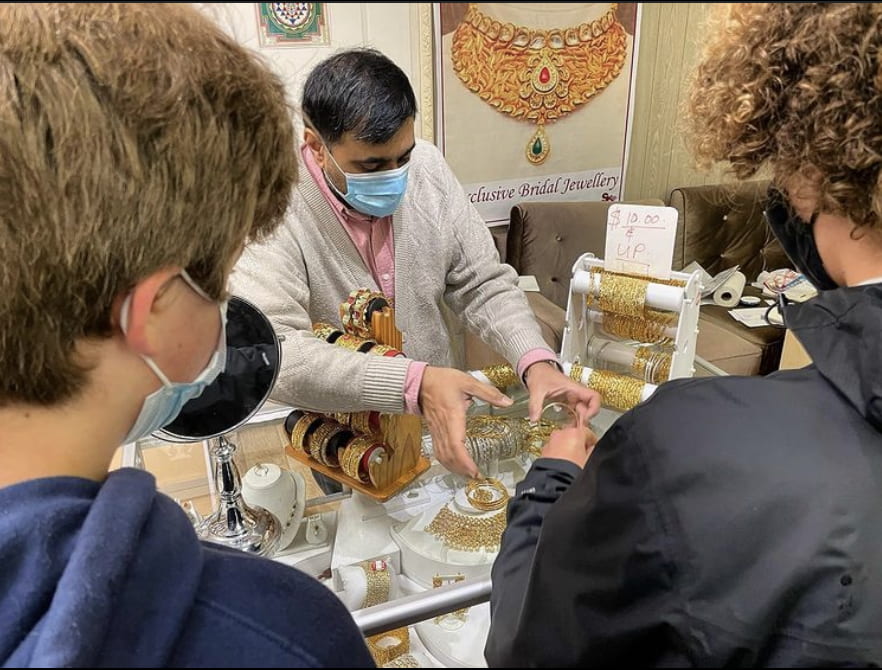
I can carry these thoughts to future learning as well as through life’s endeavours. In this project I felt that these trips were when I was able to become more understanding of the hardships of the different people. I believe it is almost impossible to fully understand the individual effects of past wrongs through text on a page, but when you are able to be where in the location it occurred, you can use your imagination to feel as though you were there when it happened which forms emotional and experiential ties that provide a respect and deeper acknowledgement of the time period or event.

My goal for Zettlekasten is to be able to form new thoughts from previous knowledge after each project. I hope to be able to use these thoughts to understand the world and how I can impact it for good. With this I can discover solutions for the problems that are all around us and become an educated person who can influence my community. Although I have already learned so much this year, I feel confident that with the connections I will make, I will be able to achieve deep and meaningful work throughout my learning journey.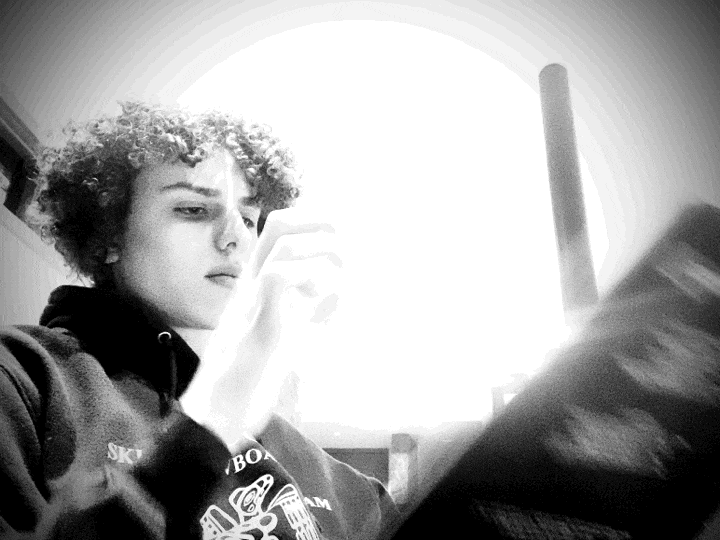
The final product was going to have to answer the driving question for this project that I mentioned before: “How can we create a public memory of past wrongs so they are not repeated today?” Using all of the knowledge we had about the importance of a public memory and what make a meaningful memorial, we were asked to brainstorm, design, model, and present an idea for a memorial on one of the three events we learned about. The class was split into tree case studies, 6 people for each one, split into two groups of 3. The two groups for each case study would each make a different memorial that we would present on the night of the exhibition. My group, Jordan, Ethan, and I were given the Komagata Maru incident to memorialize.
Thinking about it now, I didn’t realize how much knowledge I had not just on the Komagata Maru but creating a public memory as well. I didn’t think about the connections I made and the progression of my thoughts throughout the project until my group member, Jordan sparked a flame of ideas that didn’t burn out until the exhibition concluded. The idea of a anchor to represent the ship was genius, and after I referenced my notes and thoughts, the past couple months of learning broke through and was rushing into our ideas.
It was really interesting to see how much thoughts can change. Just at he start of the project, the DQ seemed like a question for a history prof, but as time when on, and I challenged myself to think critically and constantly about our learning, I was able to have the answer right in front of me in my notes.
“How can we create a public memory of past wrongs so they are not repeated today?”
we can create a public memory of past wrongs so they are not repeated today by creating a intriguing and unique memorial that connects, and informs the viewer on the event as well as empowers them to share or take action on whatever is being memorialized.
When creating the memorial, I incorporated ideals that had formed throught the course of the project. During the Komagata Maru museum and the Punjabi Market tour, the idea of memorializing a personal and individual connection, rather than just a number, stuck true to me and would be an idea I would carry to our final product. Later during the China Town visits I relized the importance of the location of the memorial, not only to form a connection to the event, but to form a connection to the community effected by the event being memorialized. During the China Town visits, I also noticed the importance of size for the memorial. During our learning of Japanese internment during WWII I discovered the importance of text and how to compose the text for the memorial. The visit to the Japanese internment museum (which was made possible be the redress settlement) sparked the idea of connection to the effected community as well as seen in the ashai exhibit. Considering the memorials I saw on the field studies and in other research, I thought about how I could better memorialize an event than the memorials I saw. There was two ideas that I felt prevalent. I decided that each memorial should not only include the ideas listed above, but also tell a story and acknowledge the events that lead up to the event being memorialized.
We incorporated all of these factors into our memorial, which is probably the main reason I am so connected to the final product. Although there were many long hours of designing and plenty of failed attempts on building the model, the end result was something that I felt conveyed our shared thinking and will always feel proud of. Not just because it took long to make, but because of the weeks of learning and working relentlessly to make meaningful observations and ideas, and being able to use all that I learned and incorporate it into one little model of an anchor. Even though you cant really see it in this post, I have realized, that the true skill is not to talk for 20 minutes about one thing, but to be able to talk for half the time and share the same amount of information, because, that’s when you know that you truly understand that what your talking about. I felt I was able to show this later in the exhibition when we presented our memorial.
I guess you dont really know how much you know untill your asked to talk about it, but during the exhibition and even now, as I write this, I am really able to see how much I actually learned. At the night of the exhibition, with my models that I spent almost all of my weekend creating, my architectural draft that used skills I learned in a engineering course I had taken earlier, and our cardboard and clay model, that Jordan had worked on endlessly in classes prior, I was ready to present what our memorial.

Even from the start of the exhibition process, where we were given our topics to memorialize, I was confident. I knew I had done enough learning and I had obtained enough knowledge on what makes a good memorial, and no matter the subject, I knew I was ready. All of the factors I covered above, could have been used in any of the events, and although some felt upset that they didn’t get the event they wanted, I knew that no matter what, I would be happy with my end result. That feeling of confidence is rare in PLP but when it does come, you know you deserved it. I think that’s why being interested and respectful to early learning is so important and that fact actually could be highlighted by teachers to make future work more meaningful. As I realized in this project and others before, sometimes time to think or organize is more important than extensive homework.
at the night of the exhibition everything came together, not out of luck but pure sweat and fears… I mean tears. Without rehearsal or even a script, I was able to tell the story of the Komagata Maru and how we, 10th grade students, created a public memory of an event that can connect to others forever. It’s pretty Incredible how much you can do if you can find that deeper meaning or purpose. That’s for anything, because it’s the ones that see value in simple exercises when others don’t that become great.
Thank you for reading this novel of a post, but I hope you leaned a thing or two, and maybe something that you can share with others, just as I am doing now. Make sure to comment any questions or thoughts you have on this post.
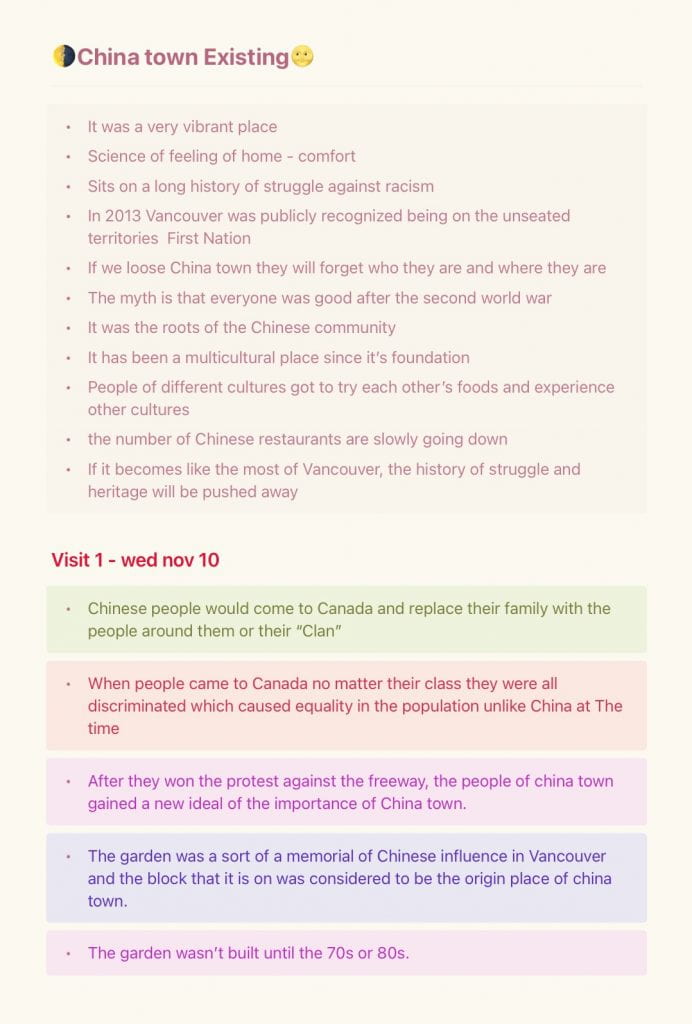


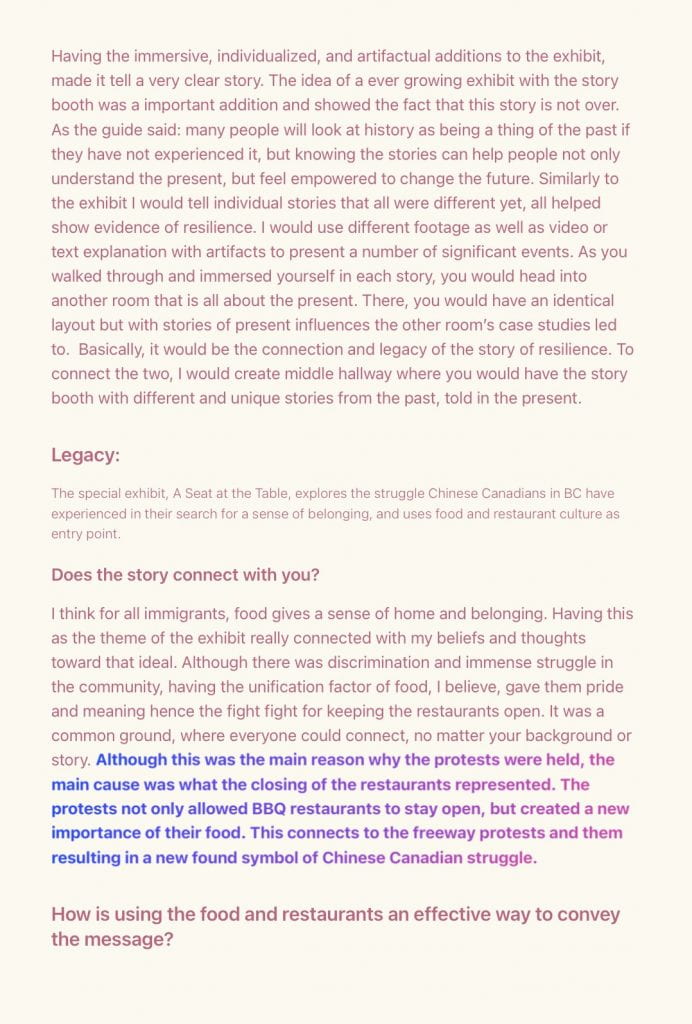


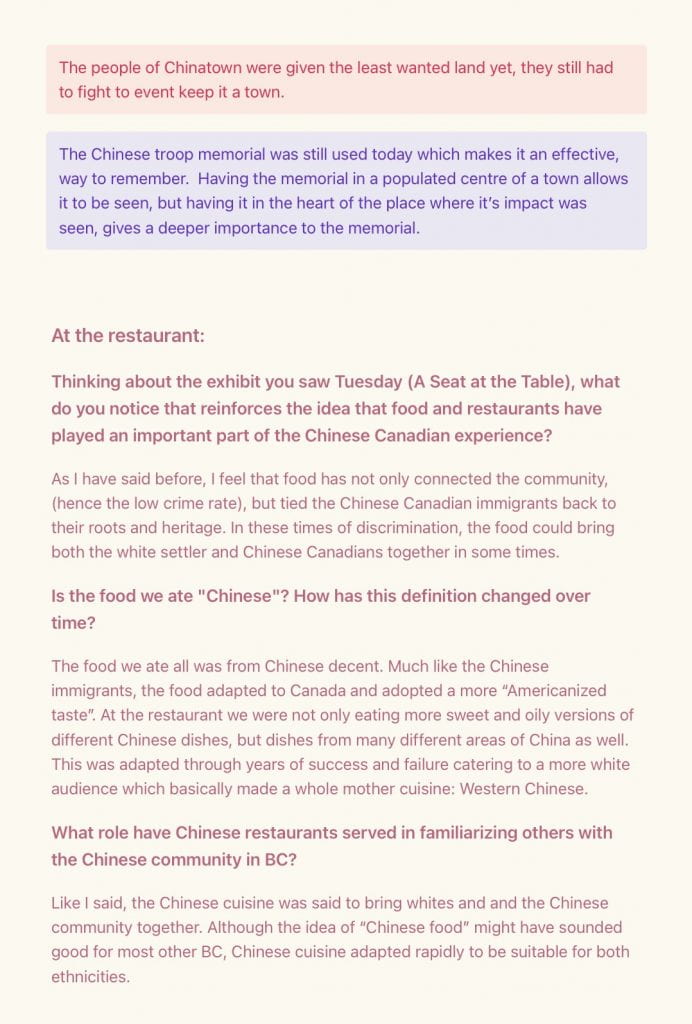

Hi Ryder! I really loved this post. I like how I got to see “inside” of your second brain by reading your Craft notes. Your render looks amazing, and your final presentation was great 🙂
Hey Ryder,
Nice blog post. So much insight and interesting perspectives that you presented. I really do think that you consider your school projects quite deeply, as well as look for intrinsic meanings and connections – whether discernable from salient, historical accounts or realized within the considerably more hidden and subtle realm of human nature and our place of belonging within this planetary, ecologically interconnected civilization.
I see, too, that looking in the direction of past historical events, and sometimes listening to their still haunting echoes, can reveal so, so many past wrongs, and so sadly, even more still being added in today’s world.
And, as you recognize, too (and I think rightly so), “we still manage to advance and grow through life” and constantly adapt. I remember a line from a movie that stuck with me through the years – it’s called Star Man (btw, good movie, maybe check it out) – so, the line from the protagonist, who is actually an ET from some distant exoplanet, is talking about the human race and he says about us: ‘you are at your very best when things are worst’…so, I think there’s a lot of truth in that.
I appreciate how you are interested in understanding the world and discovering solutions and how you mentioned that you can “become an educated person who can influence my community” – I’d only say that, of course, too, you already are becoming such an educated person, as this appears quite evident to me.
I like that photo of the light and shadow and contrast of color through the hexagonal pattern in the wall with the bus in the foreground and, is that like a sort of red fencing and lamppost? I’m thinking that you took this picture, yes?
You offer so much food for thought in your post, which just illustrates how you are giving your attention so fully to what you are learning and imagining.
You highlighted, too, on the most meaningful notes video how it’s the ‘individual stories that need to be taught in order to convey the true scale and significance of the event’ and I was reminded of the story that you researched and posted on your blog about Ibbotson Leonard and the semaphore flag.
The China Town trip seems interesting. I totally get what you mean about actually being somewhere – where the events unfolded – being “there” as you wrote – rather than just reading about them in a book. I like your comment about using one’s “imagination to feel as though you were there when it happened which forms emotional and experiential ties that provide a respect and deeper acknowledgement of the time period or event” – so, really well said!
Maybe this ‘imagining’ is a type of human empathy in practice and why we strive towards and for a moral compass? What do you think? I hear how community was so important to Chinese Canadians while maintaining connection to their heritage and culture, such as their cuisine, especially in the midst of encountering historical discrimination.
Well, this sounds like a worthy project to do in school: imagining and creating a memorial and public memory…in your group’s case, for the Komagata Maru incident… I’d like to hear about the symbolism encompassed within and expressed by the anchor memorial sometime…
So, well done on the exhibition and speaking publicly… I like the analogy of the maze, too… as it’s challenging sometimes to find the best route, yet it still exists there, all along, to be discovered. So, thanks for your post and admirable job.